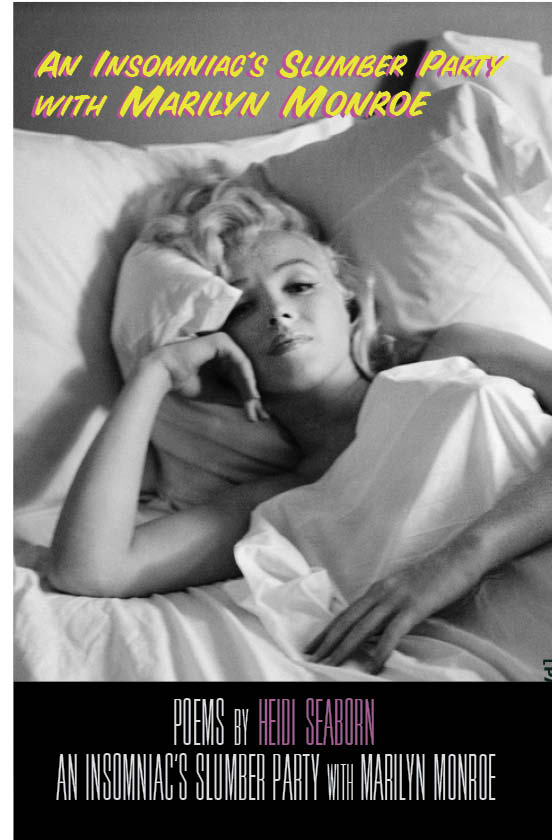Poet in the Mirror: Heidi Seaborn

We’re so proud to share some insight into the lives and hearts of today’s poets with our Poet In The Mirror series. This week, Heidi Seaborn—author of An Insomniac’s Slumber Party with Marilyn Monroe (available now from PANK)—shares insight into writing about an iconic figure, playing with form, and turning her MFA thesis into a full-length collection.
On Craft
I love the way that this book stays so closely to its subject matter and lets the poems reach toward meaning with their forms. A single couplet, followed by a poem in tercets, and then blocks of prose, for example. And then throw in an abecedarian! A letter! An interview!
What is one piece of craft advice that motivated you throughout the writing of this book? Alternatively, what is a piece of craft advice that you don’t practice yourself?
First of all, thank you for reading my newest collection An Insomniac’s Slumber Party with Marilyn Monroe and for the opportunity to discuss it with you. Frontier plays such a vital role in supporting the emerging poet and has been a great resource to me over the past few years as I’ve started writing and finding myself as a poet.
That’s an interesting observation, Saba—that form drives toward meaning in many of the poems. In the earliest drafting of what I came to think of as my Marilyn poems, they were more often in form than not. I wrote poems in everything from abecedarians and acrostics to a ziuhitsu. I was both experimenting and stretching myself as a poet, but also thinking about how the Marilyn persona emerges from the celebrity detritus. By that I mean, the form that her character has taken in our cultural psyche.
Then in the final drafting of An Insomniac’s Slumber Party with Marilyn Monroe, I intentionally broke form on many of the poems so there is just a remnant of shape or rhyme scheme left. Through revision, I was pushing for the middle-of-the-night, insomniac sensation where everything is slightly off. For example, the poem “Hello it’s Me, Marilyn” was originally a full Petrarchan crown of sonnets that then ended up as series of six sequenced poems. The shadow of the original just barely apparent. Given that this is a persona poem about Marilyn’s death, the unravelling of structure mimics what I projected was her experience that evening as she called various people, while overdosing.
As for craft advice, An Insomniac’s Slumber Party with Marilyn Monroe was my MFA thesis, so I had a lot of craft input from my professors along the way! But the consistent motivating advice was to ‘write ugly’—which was a knock on my pretty image habit but also an encouragement to write to the edge. My thesis advisor Catherine Barnett really pushed me to write ‘unknowing’ which I think of as looking over a cliff, toes hanging over. And then, you can’t really know for sure what’s down there unless you leap. It’s about bringing a sense of freefall to the writing which for me meant letting go of the control I naturally want to assert.
On Surprise in Poetry
I also love the way this collection brings the reader so close to the speaker and Marilyn. When I get too caught up in Marilyn’s story, I’m met with a surprise poem about the speaker’s insomnia and what she’s thinking in that moment. And this cycle continues throughout the book.
What was the most surprising thing—either a joyful or challenging one— about ushering this collection into the world?
I had thought I was a writing a book of persona poems that were meant to give voice to the iconic Marilyn Monroe—a cultural relic in many ways. And not a historical figure that I had any previous affinity for. But the closer I got to excavating and becoming Marilyn, the more I realized that this collection was not about her, it was about us—the poet as speaker and Marilyn, as women—and I found much of my own story in hers. Shortly before the pandemic hit, I was having coffee with Catherine Barnett, when she asked me “what is it that you have in common with Marilyn?” By then I knew we had a lot—multiple marriages, breaking work barriers—but also, fortunately, different childhood beginnings, miscarriages for her, children for me and hopefully, very different endings. But I answered Catherine with “Insomnia. It killed her. Hopefully it won’t kill me.” She said write about that. And that became the narrative structure for the book—this middle-of-the-night conversation between two insomniacs. I was able to tell Marilyn’s story within the framework of two women sharing their stories in poems.
That surprising and really delightful turn in the crafting of the book, led to the challenge of identifying speakers. In some poems, it is obvious, in others not so much. It was one of questions I debated as I revised into a final draft. Does the reader need to know who is speaking? At my thesis defense, it stirred a little debate. But by then, I had my answer—the blurring of speakers felt right for the book. Marilyn endures in our collective psyche and culture because she is both relatable and unrelatable. As a poet, I assumed her persona, or my albeit highly researched version of her. There was already a blending that had occurred that then becomes hopefully even more dimensionalized as the reader enters.
On Ekphrasis
Frontier has previously published your work, a poem whose epigraph reads “for Frida Kahlo.” This book, clearly, revolves around the speaker and Marilyn Monroe. What motivates you to write about public figures, or to write ekphrastically?
You may have recognized part of that poem that Frontier kindly published in one of the “Insomnia Diary” fragments in the book. Initially, the poem was in the collection, but then just the essence of it survived as it became part of the insomnia experience. I visited Frida Kahlo’s blue house a few years ago and was so struck by her bed, the butterflies pinned overhead the heavy presence of Diego Rivera. But it is the pillbox I bought in the gift shop that features in an ekphrastic way throughout my collection. And certainly, the entire long sequence “Divine Marilyn in Paris” is an ekphrasis of sorts. I wouldn’t say I write about public figures so much as I recognize the cultural celebration of the celebrity and am drawn to that as an intellectual topic. But I definitely had a few muses as I wrote these poems, including Frida Kahlo, Sylvia Plath, Anne Sexton, Gloria Steinem, Joyce Carol Oates, Judy Garland and of course, Marilyn.
On Rejection
What was An Insomniac’s Slumber Party With Marilyn Monroe’s relationship to rejection? How long and what did it take to find a home?
I think the most challenging aspect was not the book finding a home, but for the poems within it because many are serial, or in persona, or fragments. So, I had very low expectations for having the individual poems published. Nonetheless, I’m grateful for editors at American Poetry Journal, Cortland Review, Beloit Journal, Moria, Bracken, the Offing, Fjord and a dozen others that embraced this idiosyncratic work.
As for the book, the MFA thesis I turned in a year ago was essentially the final book, with very minor changes. I sent it in the early fall to several contests and a couple open readings. I heard back from PANK that it had won their Poetry Prize in early December. I feel quite fortunate that this book not only received recognition and found a publisher so quickly but also landed with a press that is having fun with it. For example, PANK is publishing it on June 1st, Marilyn’s 95th birthday. An Insomniac’s Slumber Party with Marilyn Monroe and Marilyn will forever have the same birthday!
On Writing the Difficult Poems
What was it like to spend so much time with Marilyn Monroe, and especially her tragedy? What do you do to re-energize yourself when writing about such difficult subjects?
One of my sisters was visiting at some time during the two years of writing this book, and she looked at the bookcase next to my desk and said, “What’s the deal with Marilyn Monroe?” I read everything Monroe, or loosely connected to her (biographies of DiMaggio, Miller), I lived on auction sites and on NYU’s online library, then I watched all her films. I went deep. With a starting point of knowing essentially nothing about Marilyn, I came to know her intimately. But I wrote the poems out of sequence. I started with her tragic end and her broken childhood and wrote to the middle of her life. It wasn’t a deliberate tactic, but it did lessen the intensity. And then there’s the revising and craft which for me serves as an emotional prophylactic.
On the Pandemic
How did the pandemic inform or effect An Insomniac’s Slumber Party with Marilyn Monroe?
When the pandemic arrived, I was in the middle of my thesis semester which was a blessing. I was writing, reading, engaged in critical work. Really heads down through the end of May. So that early, intense lockdown might have been beneficially in some ways. Bringing a new book out into the world while we continue to be unable to have events in person is really the biggest challenge and disappointment. I love how the literary community has rallied to support authors with the plethora of online readings and celebrations. And how people started reading more books and more poetry during the pandemic. I hope all those trends continue. My book tour is largely virtual over the summer, but there are events starting to come onto the schedule for late summer and fall that are in person. I think how special it will be to read again in a bookstore or a bar or a festival.
Thank you Saba for this conversation and the opportunity to talk about the behind the scenes of the making of my new collection.
 Heidi Seaborn is the author of [PANK] Poetry Prize winner An Insomniac’s Slumber Party with Marilyn Monroe (2021), the acclaimed Give a Girl Chaos (C&R Press, 2019) and the 2020 Comstock Review Chapbook Award-winning, Bite Marks. Recent work in American Poetry Journal, Beloit Poetry Journal, Copper Nickel, The Cortland Review, The Financial Times, The Greensboro Review, LitHub, The Offing, The Slowdown with Tracy K. Smith, Tinderbox and elsewhere. She’s Executive Editor of The Adroit Journal and holds an MFA in Poetry from NYU. heidiseabornpoet.com
Heidi Seaborn is the author of [PANK] Poetry Prize winner An Insomniac’s Slumber Party with Marilyn Monroe (2021), the acclaimed Give a Girl Chaos (C&R Press, 2019) and the 2020 Comstock Review Chapbook Award-winning, Bite Marks. Recent work in American Poetry Journal, Beloit Poetry Journal, Copper Nickel, The Cortland Review, The Financial Times, The Greensboro Review, LitHub, The Offing, The Slowdown with Tracy K. Smith, Tinderbox and elsewhere. She’s Executive Editor of The Adroit Journal and holds an MFA in Poetry from NYU. heidiseabornpoet.com
Saba Keramati
Saba Keramati is a Chinese-Iranian writer from the San Francisco Bay Area. A graduate of University of Michigan and UC Davis, her work has been nominated for a Pushcart Prize, and appears or is forthcoming in Michigan Quarterly Review, Glass: A Journal of Poetry, Vagabond City Lit, and other publications. You can follow her on Twitter @sabzi_k.